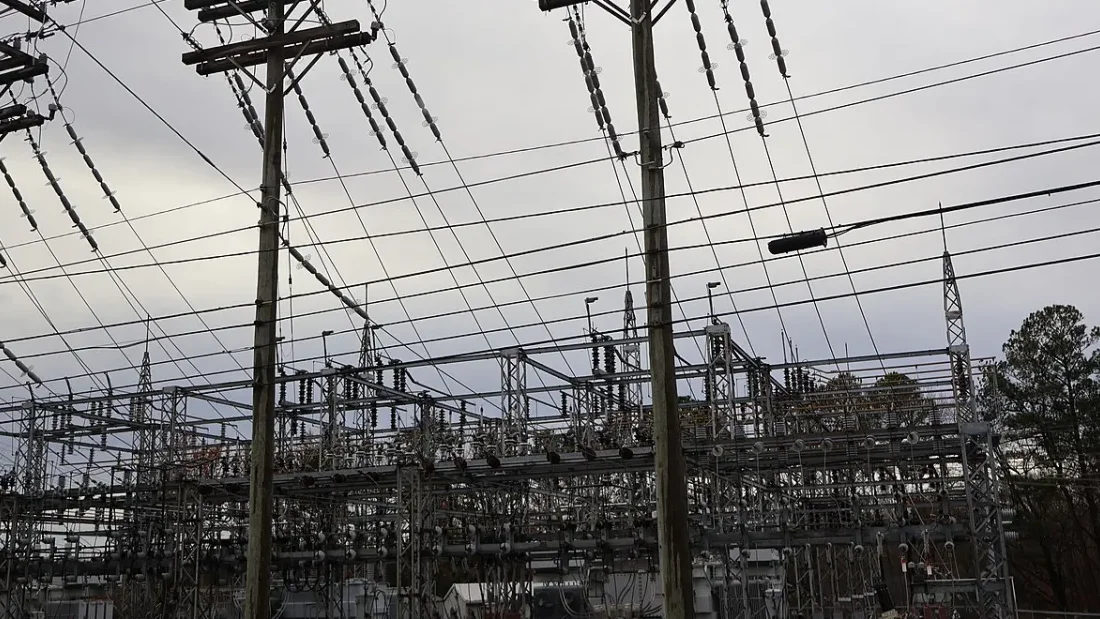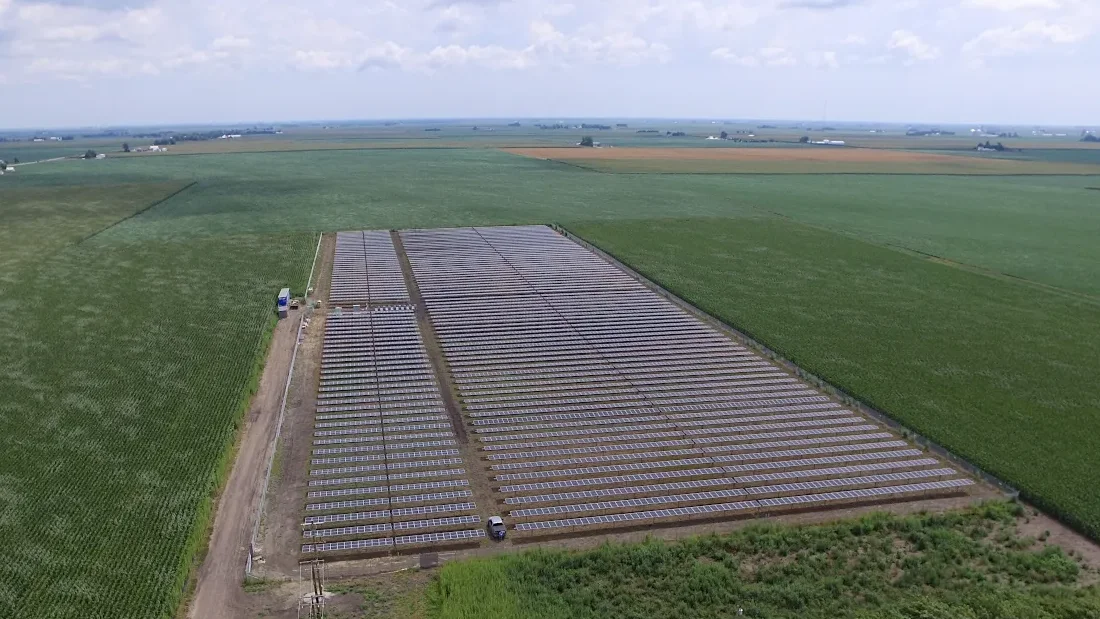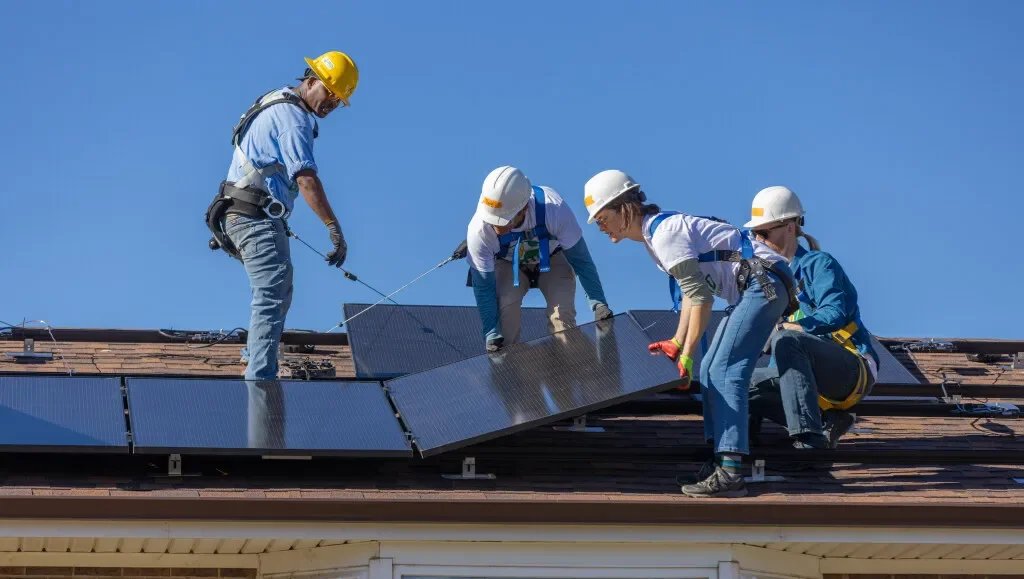
OIL & GAS: Tennessee Valley Authority, Duke Energy and Georgia Power — three of the Southeast’s biggest utilities — want to build more natural gas-fired power into their long range plans, despite the Biden administration’s hopes for more carbon-free energy. (E&E News)
ALSO:
OVERSIGHT:
UTILITIES:
SOLAR:
EFFICIENCY: A Democratic West Virginia lawmaker spotlights job creation in an effort to win more support for legislation to spur energy efficiency programs in the state. (Mountain State Spotlight)
WIND: A Virginia judge dismisses lawsuits trying to block a planned 13-turbine wind farm atop a mountain. (Roanoke Times)
ELECTRIC VEHICLES:
CLEAN ENERGY: A Virginia commission to promote economic growth in former tobacco-producing areas announces a matching grant program that could deliver up to $12 million for “high-impact” energy projects. (Cardinal News)

GRID: Federal Energy Regulatory Commission Chairman Willie Phillips says recent winter storms highlight the need for “equitable and forward-thinking transmission solutions” to ensure long-term reliability. (Utility Dive)
ALSO: Texas’ power grid broke records for winter demand but withstood last week’s polar vortex, while a largely partisan debate continues over whether added renewables or natural gas facilities deserve more credit for avoiding outages. (Utility Dive, Inside Climate News)
ELECTRIC VEHICLES:
CLIMATE:
WIND:
OIL & GAS:
SOLAR: Tribal nations say Washington state’s solar permitting and siting process threatens cultural resources and Indigenous foodways by relying on often-inadequate developer-sponsored archaeological surveys. (High Country News)
UTILITIES: Xcel Energy wants time-of-use rates to be the default billing system for its Minnesota residential customers, proposing to double prices for power during peak late afternoon and early evening hours. (Energy News Network)
MINING: Advocates worry that a flurry of lithium, copper and other critical material mining proposals will further strain drought-stressed Southwestern water supplies. (Inside Climate News)
CLEAN ENERGY: A Michigan lawmaker says the timing of the federal Inflation Reduction Act was a significant reason why the state passed sweeping clean energy reforms last year. (Volts)

New Hampshire’s energy department is preparing to road-test a grant program meant to help disadvantaged cities and towns access the environmental and financial benefits of solar power.
The state plans to use $1.4 million from the 2021 federal Bipartisan Infrastructure Act to help fund the installation of solar projects up to 60 kilowatts on municipal buildings or land. The grant will cover up to 95% of the costs of a qualifying solar project for lower-income cities and towns and 60% for other municipalities.
In addition to cutting carbon emissions, solar can also make a community more resilient in case of power outages. And using it to power municipal facilities can save money that can be reinvested in public projects or used to hold down property tax rates in the long-term.
The funding application has been submitted to the U.S. Department of Energy, and New Hampshire is now in “wait-and-see mode,” said Joshua Elliott, director of policy and programs in the state energy department.
The state is also looking at the program as something of a trial run, to see if it makes sense to continue and expand the grant offering in the future.
“We’re looking at this program as almost the guinea pig to see what demand is out there, what can we do, what we can improve,” Elliott said. “Then we’ll use this process to inform what potentially a [larger] municipal program could look like.”
As a whole, New Hampshire lags the region in solar adoption. The state ranks 41st in the country for installed solar capacity, behind even lower-population New England states like Maine, Rhode Island, and Vermont, according to the Solar Energy Industry Association. State policies to encourage solar are limited, with incentives for residential solar maxing out at $1,000 per project and rebates for commercial solar limited to $10,000.
On the municipal level, though, many New Hampshire cities and towns are very interested in solar power. For example, in Hanover, a more affluent town and the home of Dartmouth College, solar arrays provide nearly all the power used by municipal facilities. Smaller towns and those with lower average incomes, however, often have a harder time realizing their solar goals.
New Hampshire property owners already have one of the highest property tax burdens in the country, so proposing that the residents of small, disadvantaged towns pay more to install solar is a big ask, even if there could be financial benefits down the line. Beyond the issue of funding, there are the logistics: researching options, hiring consultants, assessing different grant options.
“If you have the idea that you want solar on the town hall, you have to go from the idea to the implementation,” said Margaret Byrnes, executive director of the New Hampshire Municipal Association. “For municipalities that don’t have that internal staff, it’s a significant lift.”
The grant program aims to lighten that burden. And to maximize the benefits these towns can achieve, the grant guidelines encourage municipalities to skip entering into leasing arrangements and instead buy their solar arrays outright, so they retain the rights to sell renewable energy credits.
“We want all of those benefits flowing to the community itself,” Elliott said.
Colebrook, a town of roughly 2,000 people just 10 miles south of the Canadian border, is looking at the grant program as a potential way to fund a solar array on the roof of its town hall. Tourism is the main economic driver in the remote and scenic town, and there is little industry and few high-paying jobs. The median household income in town is just over $48,000, well below the state median of $91,000.
“We can’t just go out and ask for $150,000 from the town to foot the bill” for a solar project, said Colebrook town manager Tim Stevens. “Any time you have to go back to the town and ask for more money than you did before, that has a negative impact on them.”
Hinsdale, a small town near the state’s southern border, has plans to open its transfer station full-time and hopes to build a solar array on the site to help power the operation. A recent report, however, found that most residents’ property taxes had increased between 25% and 48% between 2018 and 2022, making it challenging to ask for yet more money. And there’s a bridge in town that needs to be rebuilt and other pressing infrastructure issues.
“Unfortunately, solar is not on that priority list,” said Josh Green, Hinsdale’s community development coordinator.
He estimates that a 60-kilowatt array at the transfer station would cost about $260,000. With the grant, the town would only have to pay about $13,000 of that total tab.
“The solar grant would definitely help the town out tremendously,” Green said.
Though the planned grant program is modest in size — the total budget will likely be able to fund only a handful of projects — it is well-tailored to the needs of the state, said Melissa Elander of Clean Energy New Hampshire, a nonprofit advocacy group that has been working with municipalities in the northern part of the state to prepare for the launch of the grants.
“It’s a good fit to focus on smaller towns that often get forgotten in some of the larger grant programs,” she said. “I am thrilled that it’s going to be available at all.”

Some environmental advocates are striking a new tone as they urge skeptical neighbors to see the larger climate benefits of a proposed port that would help build future offshore wind farms in the Gulf of Maine.
The fast-warming area of the North Atlantic is thought to have one of the world’s best wind resources in its deeper waters. Tapping into this huge renewable energy potential will likely require massive floating turbines, with a deepwater port to help construct and assemble them before they’re towed out to sea.
A state announcement on one of two potential port sites in the small Midcoast town of Searsport is expected in the coming weeks. Amid a record spate of destructive extreme weather events, conservation groups are stepping up calls for the public to back some version of the port project for the climate’s sake.
“The number one best thing to do for the environment is to get turbines in the water and start generating renewable energy,” said Nick Lund, the advocacy and outreach manager for Maine Audubon. “This is a larger question than just Searsport, because it really does affect all of us.”
Offshore wind is crucial to Maine’s goals for reducing its carbon emissions, Lund said, and offers a unique chance for the state to contribute its resources to the national and global fight against climate change.
Maine Audubon, which predates and is separate from the National Audubon Society, hopes to reframe the debate around the port and offshore wind in general as more than a “lesser of two evils,” he said.
“This type of turbine is not something that can be built elsewhere,” Lund said. “This is a real opportunity to generate a ton of energy completely locally. Other states, other countries don’t have this opportunity.”
Maine depends more on carbon-intensive fuel oil for home heating than any other state, importing it largely from Texas, Louisiana and Canada, according to federal data. The state has encouraged residents to switch to electric heat pumps and hopes to get 80% of its electricity from renewable sources by 2030.
But a boom in local solar projects has raised land-use concerns, and residents have repeatedly pushed back on transmission lines planned to bring Canadian hydropower or land-based wind from Northern Maine onto the regional grid. Some Maine fishing groups also oppose offshore wind development.
Lund said Maine Audubon is trying to turn toward saying “yes” rather than “no” to projects with a net benefit for the climate. The group has spent years developing habitat-minded siting guidance for solar developers, and executive director Andy Beahm wrote a newspaper commentary in 2023 urging support for offshore wind and calling climate change “the No. 1 threat to Maine wildlife and habitat.”
Around the same time, the National Audubon Society put out a report supporting transmission build-out for climate reasons despite potential impacts to birds. Environmentalist Bill McKibben also wrote that summer that “some NIMBY (not in my backyard) passion will need to be replaced by some YIMBY (yes in my backyard) enthusiasm — or at least some acquiescence” in order to fight the climate crisis equitably.
In an interview soon after his commentary was published, Beahm acknowledged that localized energy development may feel new to many Mainers: “Maine is highly dependent on others for our energy,” he said. “As a consequence, we haven’t had to see a lot of the power infrastructure from our communities.”
But his group and others are increasingly arguing that this needs to change. If Maine can’t tap into its offshore wind potential, it could see far more land used for solar, Lund said — or could help drive fossil fuel growth in already overburdened environmental justice areas of Appalachia and the Gulf South.
“If we say no to everything here,” Lund said, “someone else, someone with less power — their land is being developed.”
It will take a rare kind of port to help build and deploy turbine assemblies that are expected to be taller than the Washington Monument, with blades and installation vessels more than 400 feet long, according to a 2021 port feasibility study by the state Department of Transportation.
“Those locations in Searsport are, by far, the sort of best available — certainly in Maine and in New England,” Lund said. “Without a deepwater port, we’re simply not going to have floating offshore wind in the time that we need.”
The state has zeroed in on two potential wind port sites in Searsport: Mack Point, a piece of shoreline that now partly houses a Sprague Energy oil and cargo terminal; and Sears Island, a state-owned conservation area popular for birding and outdoor recreation.
Sears Island is one of the largest undeveloped islands in Maine, managed by a 2009 conservation easement that set about a third of its area aside for a potential future port. The island was unsuccessfully eyed for a nuclear plant, a coal plant, a container port and an LNG terminal in decades past, according to a state committee that overcame “years of acrimony and controversy” to negotiate the easement.
The 2021 study listed Sears Island as a preferable wind port site, partly because building one at Mack Point would require costly dredging. But some Mainers have pushed back hard against the idea of this use for part of DOT’s Sears Island set-aside, with officials predicting protest “sleep-ins” if they go this route.
A state working group has spent more than a year considering ways to minimize Mack Point’s potential cost and dredging issues — with buy-in from the site’s current owner, Sprague — and recent editorials in Maine newspapers have supported it as a better choice over Sears Island.
“Locating the offshore wind port at Mack Point consolidates industry in a single location and removes unused physical remnants of outdated energy production that offshore wind intends to replace with clean, renewable, more sustainable energy production,” Sierra Club Maine director Pete Nichols wrote in the Portland Press Herald on Jan. 18.
Lund said Maine Audubon agrees that Mack Point is the preferable site, and that choosing it could help the state avoid costly legal challenges. “And,” he said, “I’m better with delay than I am with not getting it built at all — that’s really the worst outcome.”
He said his group is most interested in seeing the project move forward, and in working to mitigate and offset any environmental impacts wherever it’s located.

GAS: Vermont’s top court dismisses a lawsuit against the state’s main gas utility that sought to prevent it from buying and distributing methane from a large New York landfill, a plan criticized by some as a greenwashing scheme. (Seven Days)
ALSO: Three oil tankers catch fire in Epping, New Hampshire, leading to a massive response from neighboring fire departments. (WMUR)
ELECTRIC VEHICLES:
SOLAR:
CLEAN ENERGY: Rhode Island’s Block Island is now running on only renewable energy, roughly six years after it became home to the country’s first offshore wind farm. (news release)
CLIMATE: A new study shows how New England states have seen a precipitous drop in snowpack since the 1980’s, a problem evident at the region’s mountain resorts, which increasingly rely on making their own snow. (Boston Globe, Stowe Reporter)
POLICY:
GRID: Relatively few power outages are being reported this morning across the region even though thousands lost power over the weekend amid a major winter storm. (PowerOutage.US, In-Depth NH, WGRZ, )
AFFORDABILITY: Connecticut politicians debate whether to direct surplus state funds to help shrink the unmet residential demand for heating bill financial assistance. (CT Mirror)
COMMENTARY: A New Hampshire farmer details how climate change has “upended” standard seasonal weather patterns over the past four decades and how that impacts his business. (Concord Monitor)

EMISSIONS: The EPA proposes new rules that would charge oil and gas producers methane emissions fees starting at $900 per metric ton and rising to $1,500 by 2026. (The Hill)
ALSO: Advocates celebrate proposed U.S. EPA restrictions on pollution from waste-to-energy facilities but say they don’t go far enough to combat environmental justice concerns. (Inside Climate News)
CLIMATE:
CLEAN ENERGY:
GAS:
PIPELINES:
SOLAR: Xcel Energy’s plan to replace one of the country’s largest coal plants with solar on the same site is meant to minimize economic losses for the local Minnesota community. (Inside Climate News)
CLEANTECH: Massachusetts’ booming clean tech economy is expanding, and politicians, including the state’s governor, are looking at how to keep that growth in state. (Boston Globe)
WIND: A northern California port commits to using electricity instead of diesel to power a planned terminal that would serve the offshore wind industry. (JPR)
CARBON CAPTURE: California’s petroleum companies look to survive the transition from fossil fuels by establishing a carbon management industry that stores captured greenhouse gasses in depleted oil fields. (Los Angeles Times)

WORKFORCE: Renewable energy is boosting West Virginia with a series of new factories and projects, but the state is hampered by a low labor force participation rate and lack of policies supporting smaller community-scale projects. (Mountain State Spotlight)
GRID:
STORAGE: A Louisiana parish board votes to approve tax incentives for a chemical company to build a $491 million factory to make materials for electric vehicle batteries. (NOLA.com)
EFFICIENCY: Duke Energy introduces a North Carolina program to incentivize homeowners with high energy usage to add energy-efficient HVAC systems, insulation and other measures. (Raleigh News & Observer)
SOLAR:
CLIMATE:
PIPELINES: A North Carolina county board delays approval of a permit for Dominion Energy to use a property as an operational base to build a pipeline after residents raise concerns about safety and pollution. (Salisbury Post)
COAL: A federal judge orders a helicopter owned by West Virginia Gov. Jim Justice’s coal companies to be prepared for sale to satisfy a debt to a company for royalty payments for mined coal. (WV Metro News)
OIL & GAS: Wind carries a natural gas odor from an oil field into Austin, Texas, fueling concerns from residents. (KVUE)
UTILITIES:
COMMENTARY:

POWER PLANTS: South Dakota regulators ask Xcel Energy to reconsider closing two large Minnesota coal plants in the coming years based on concerns over whether there will be adequate power on the grid. (Utility Dive)
ALSO: Dozens of residents, local officials and business leaders are divided over Minnesota Power’s plans for a 550 MW natural gas plant in northern Wisconsin near Lake Superior. (Northern News Now)
ELECTRIC VEHICLES:
BIOGAS: Michigan environmental groups raise concerns over legislation that would define biogas from animal waste at industrial farms as clean energy. (Metro Times)
NUCLEAR: Despite growing public and governmental support for nuclear power, industry experts say it’s unclear when the next U.S. reactor may come online. (Canary Media)
EFFICIENCY: An Illinois school district saved $4.3 million in energy costs by investing in energy efficiency measures at multiple schools. (WGLT)
SOLAR:
CLIMATE: Indiana youth climate activists call on state lawmakers to pass bills supporting community solar, creating incentives for wetland protections and requiring permits for large water withdrawals. (Indiana Public Radio)
RENEWABLES: A western Nebraska county board approves a six-month moratorium on utility-scale wind and solar projects as it considers local regulations. (Nebraska Rural Radio)
COMMENTARY:

SOLAR: The U.S. military will install rooftop solar panels on the Pentagon as part of a $250 million package announced Wednesday to reduce emissions from federal buildings. (Associated Press)
ALSO:
ELECTRIC VEHICLES:
NUCLEAR:
POLITICS:
WORKFORCE: Renewable energy is boosting West Virginia with a series of new factories and projects, but the state is hampered by a low labor force participation rate and lack of policies supporting smaller community-scale projects. (Mountain State Spotlight)
GRID:

SOLAR: The Biden administration adds Idaho, Montana, Oregon, Washington and Wyoming to the original six states in its federal land solar development plan, saying the additional 22 million acres are needed to meet the nation’s clean energy needs. (The Hill)
ALSO:
CLEAN ENERGY: Fierce debate breaks out over proposed Alaska legislation that would require utilities to generate 80% of their electricity from renewable sources by 2040. (Northern Journal)
OIL & GAS:
NUCLEAR: The Biden administration approves spending $1.1 billion to help keep the Diablo Canyon nuclear plant in California running beyond its previously scheduled 2025 retirement date. (Associated Press)
UTILITIES:
CLIMATE: Washington voters will have a chance this November to vote on a ballot measure to repeal or uphold the state’s two-year-old landmark climate policy. (Spokesman-Review)
ELECTRIC VEHICLES: A California air pollution control district receives $56 million in federal funds to develop an electric freight-truck charging network. (Turlock Journal)
COAL: A Colorado private equity firm throws a financial lifeline to a struggling Wyoming coal processing company that claims a cleaner production method. (Cowboy State Daily)